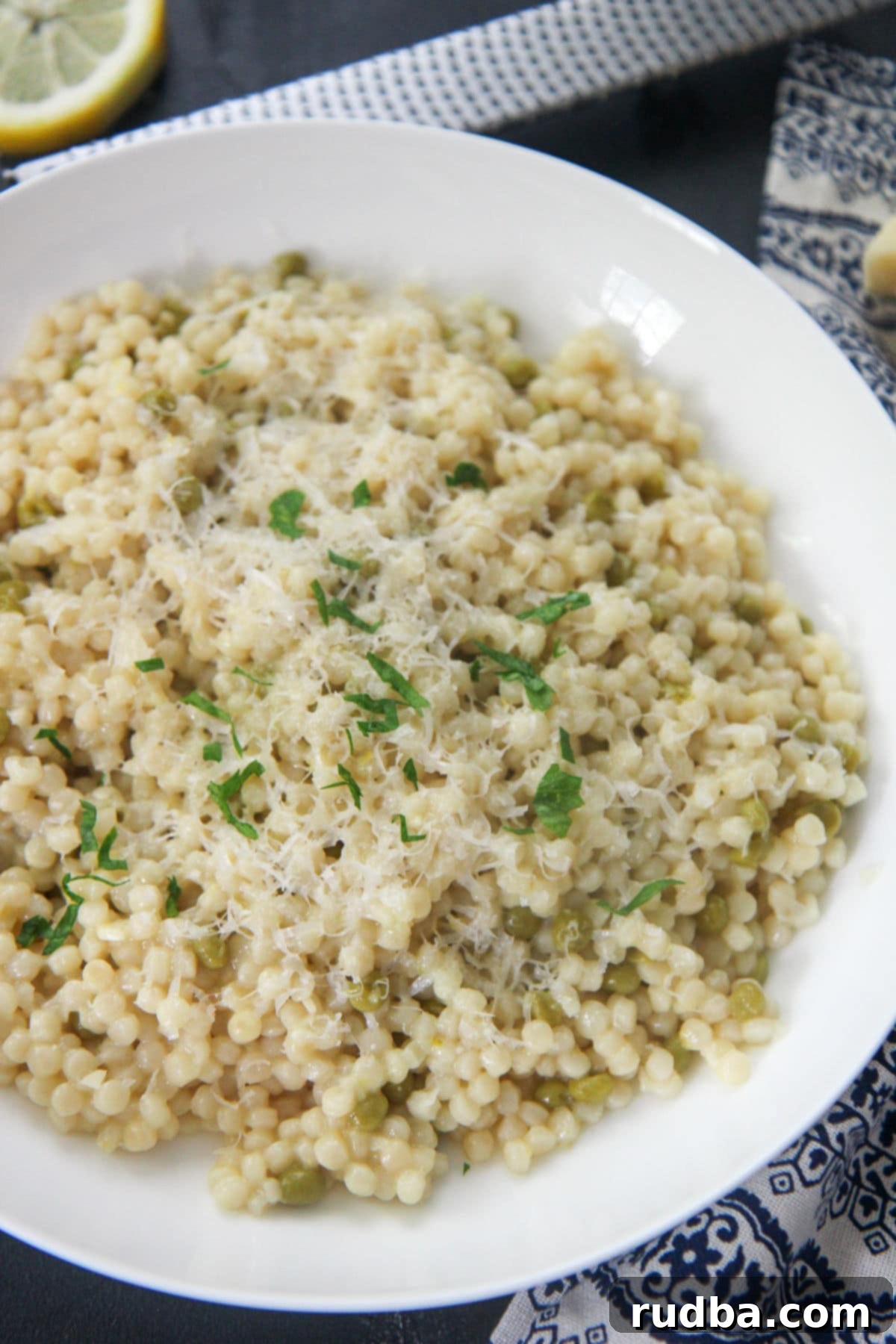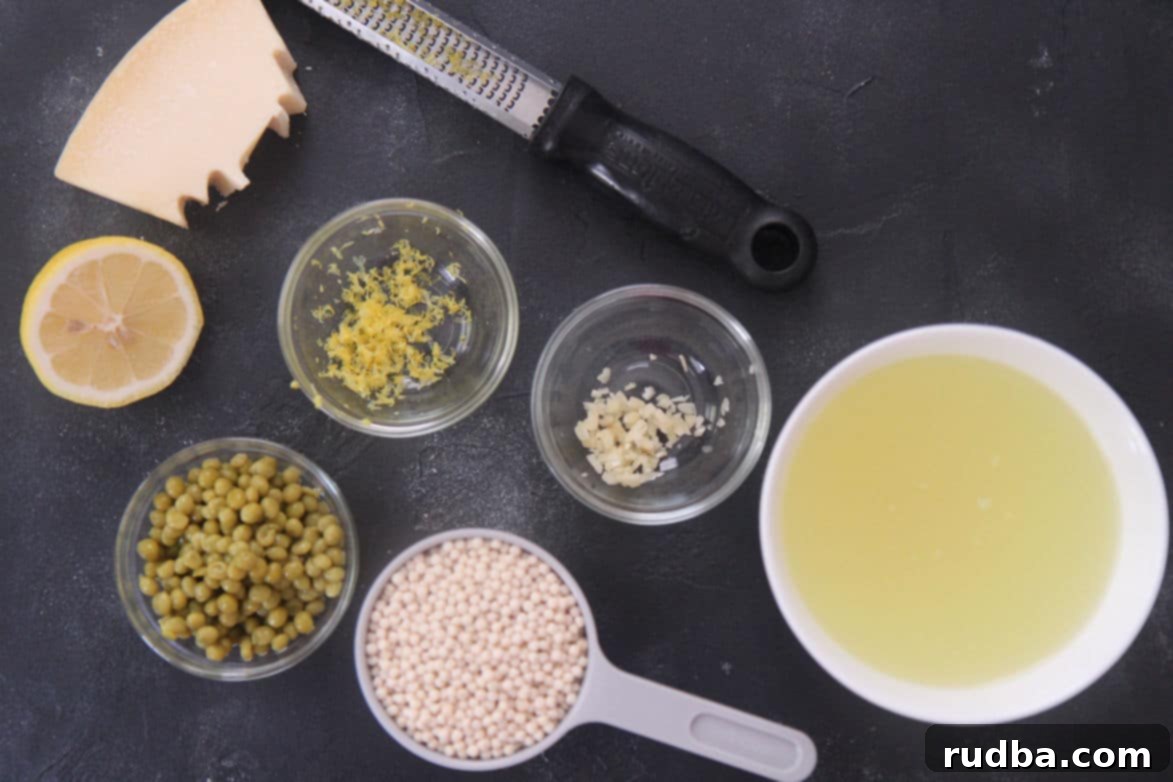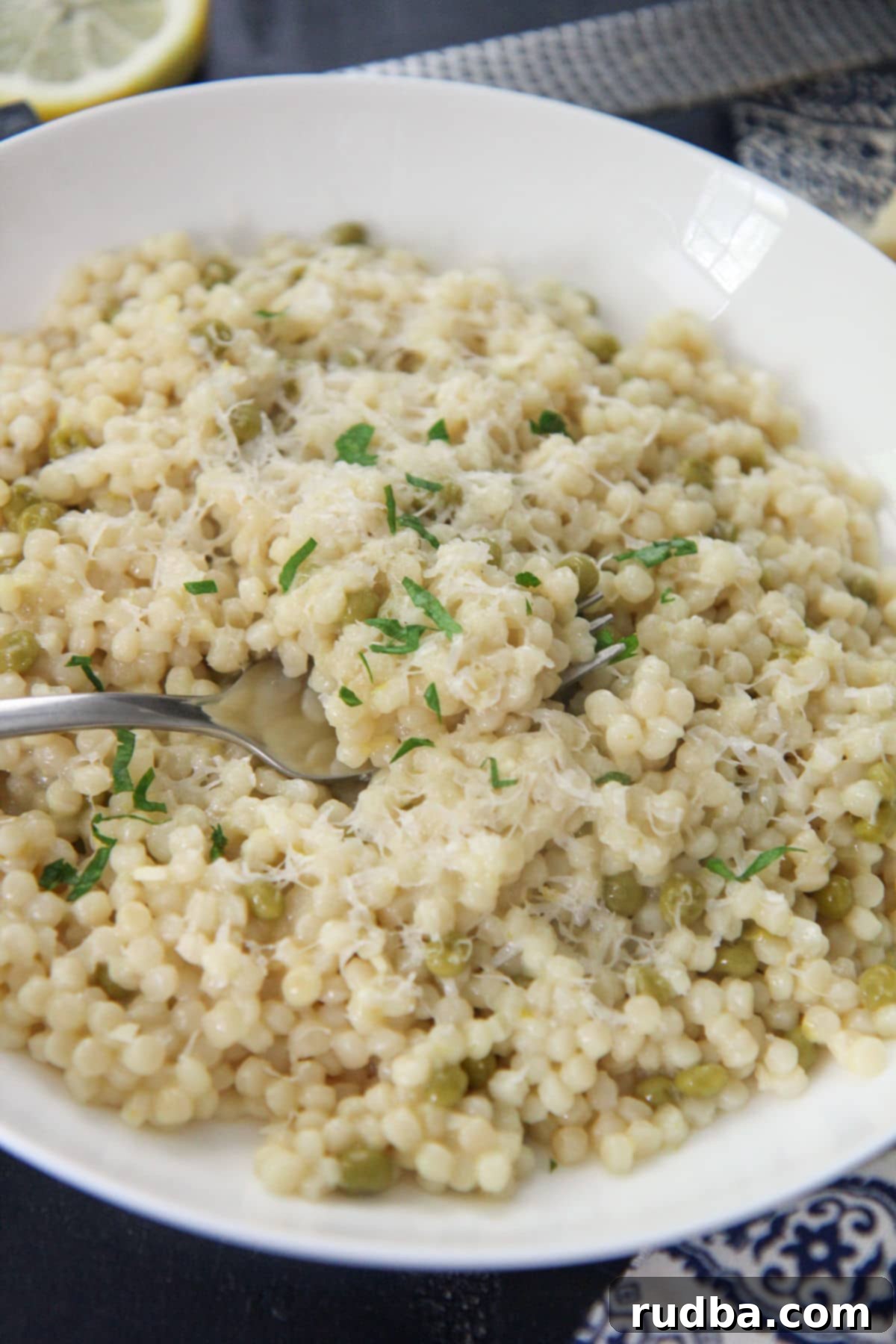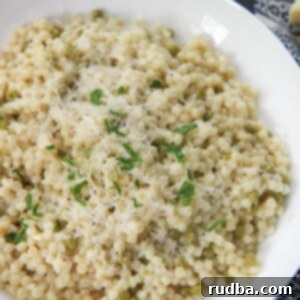Flavorful Lemon Israeli Couscous: Your Go-To Quick & Easy Side Dish Recipe
Get ready to discover your new favorite weeknight companion: Lemon Israeli Couscous! This incredibly simple yet profoundly flavorful dish is a game-changer for busy evenings. Whether you’re pairing it with a succulent protein or enjoying it as a light meal on its own, its bright, zesty notes and delightful texture are sure to impress. Forget bland sides – this pearl couscous is packed with vibrant lemon, aromatic garlic, sweet peas, and savory Parmesan, creating a symphony of flavors that complements almost any dinner.

The beauty of this Lemon Israeli Couscous recipe lies in its remarkable versatility. It shines equally whether served warm alongside a hearty main course or chilled as a refreshing addition to a summer salad. Its unique pearl-like shape and slightly chewy bite offer a satisfying alternative to traditional rice or pasta. I especially love serving this bright couscous with seafood, as the lemon perfectly complements the delicate flavors of fish and shrimp. Imagine it next to Pan-Seared Salmon with Lemon Butter, succulent Creamy Garlic Shrimp, or even Crab-Stuffed Salmon for an elevated dinner experience. It’s also fantastic with Shrimp Scampi, where the couscous can soak up all that garlicky, buttery goodness!
Beyond its role as a perfect pairing for seafood, this Lemon Israeli Couscous can easily transition from a vibrant side dish to a satisfying main course with a few simple additions. It’s a fantastic base for adding roasted vegetables, chickpeas, or grilled chicken. When you’re at the grocery store, you’ll find various types of pearl Israeli couscous, so be sure to pick up the original, unflavored kind to build these wonderful flavors from scratch.
If you’re tired of serving the same old rice and potatoes night after night, this Israeli couscous recipe is exactly what you need. It’s not only incredibly delicious but also one of the easiest and quickest side dishes you can whip up, making it a staple in your culinary repertoire.
What is Israeli Couscous? (Pearl Couscous Explained)
Israeli couscous, often referred to as pearl couscous or Jerusalem couscous, is a unique type of toasted pasta, not actually a grain like traditional couscous. Unlike its finer North African counterpart, Israeli couscous features distinct, small, round spheres that resemble tiny pearls, hence the popular “pearl couscous” moniker. These little pasta balls are toasted, giving them a slightly nutty flavor and a wonderfully satisfying chewiness that sets them apart. It’s incredibly versatile and can be served in a myriad of ways: as a warm, comforting side dish, a robust main entree when augmented with other ingredients, or even as a refreshing addition to cold salads. Its ability to absorb flavors and its delightful texture make it a favorite among home cooks and professional chefs alike.
Originating in Israel in the 1950s when rice was scarce, it was developed as a rice substitute using durum wheat. Today, it’s celebrated globally for its unique characteristics and ease of preparation. This makes it a fantastic canvas for various flavor profiles, from savory and robust to light and zesty, like in our lemon-infused version.
Why You’ll Adore This Lemon Israeli Couscous Recipe
- Effortlessly Easy: With just a few simple steps, you can create a sophisticated side dish that tastes like you spent hours in the kitchen. Perfect for beginners and seasoned cooks alike.
- Lightning Fast: Ready in under 20 minutes from start to finish, it’s ideal for those busy weeknights when time is precious but you still crave something delicious and homemade.
- Vibrantly Flavorful: The combination of fresh lemon juice and zest, savory garlic, and a hint of Parmesan creates an incredibly bright and refreshing taste profile that awakens the palate.
- Incredibly Versatile: Serve it hot or cold, as a side dish or a light main. It pairs wonderfully with almost any protein, from fish and shrimp to chicken and even tofu.
- Texture Perfection: The unique pearl-like texture of Israeli couscous, slightly chewy and robust, offers a delightful contrast to softer ingredients and stands up well to various sauces.
- Elevates Any Meal: This dish isn’t just a side; it’s a culinary highlight that can transform an ordinary dinner into something special.
Essential Ingredients for Your Zesty Israeli Couscous
Gathering your ingredients for this Lemon Israeli Couscous is straightforward. You’ll need just a handful of fresh, high-quality components to create maximum flavor:
- Israeli Couscous: The star of the show! Look for the unflavored, traditional pearl couscous. Its unique texture is key.
- Fresh Lemon Juice: Freshly squeezed lemon juice is non-negotiable here. It provides the essential bright, tart flavor that defines this dish.
- Lemon Zest: Don’t skip the zest! It contains the lemon’s essential oils, adding an incredible depth of citrus aroma and flavor that juice alone can’t achieve.
- Garlic: Freshly minced garlic provides an aromatic base, complementing the lemon beautifully without overpowering it.
- Peas: Frozen green peas are perfect for convenience, adding a pop of color and a touch of sweetness.
- Fresh Parmesan Cheese: Grated Parmesan adds a salty, umami depth and creamy richness when stirred in at the end.
- Chicken Stock: Using chicken stock instead of water infuses the couscous with more flavor. Vegetable stock can be used for a vegetarian version.
- Olive Oil: A good quality extra virgin olive oil is used for toasting the couscous and garlic, enhancing their flavors.
- Salt and Pepper: To season to taste, bringing all the flavors into balance.
- Fresh Parsley (for garnish): Optional but highly recommended for a fresh, herbaceous finish and a splash of color.

Step-by-Step Guide: Crafting Your Delicious Lemon Israeli Couscous
While most Israeli couscous packaging suggests simply boiling it in water, my preferred method involves a crucial toasting step. This technique in olive oil with garlic and lemon zest before adding the liquid develops a richer, nuttier flavor and prevents the couscous from becoming sticky. Here’s a detailed breakdown of how to prepare this vibrant dish for perfect results every time:
- Heat the Skillet: Begin by adding a generous drizzle of good quality olive oil to a large skillet with high sides. This ensures enough surface area for the couscous to toast evenly and prevents overflow when the liquid is added. Heat the oil over medium heat until it shimmers slightly.
- Sauté the Garlic: Add the finely minced garlic to the heated olive oil. Cook for a brief 20 seconds, stirring constantly. The goal here is to release its fragrant aroma without browning or burning it, which can make it bitter.
- Toast the Couscous and Zest: Stir in the dry Israeli couscous and the lemon zest. Continue to cook for an additional 2 minutes, stirring frequently. This step is key! Toasting the couscous enhances its nutty flavor and creates a slight barrier that prevents it from clumping. The lemon zest infuses the oil and couscous with a beautiful citrus aroma from the start. You’ll notice the couscous turn a slightly golden color.
- Add Liquids and Simmer: Carefully pour in the chicken stock and fresh lemon juice. Season with salt to taste (remembering that chicken stock can already be salty, so start with a little and adjust later). Bring the mixture to a gentle boil, then immediately reduce the heat to low, cover the skillet tightly with a lid, and let it simmer for 15 minutes. This allows the couscous to absorb the liquid and cook through, becoming plump and tender.
- Incorporate Peas and Parmesan: Once the 15 minutes are up, check the couscous to ensure it’s fully cooked and has absorbed most of the liquid. Remove the skillet from the heat. Stir in the green peas (if using frozen, the residual heat will warm them through) and the grated Parmesan cheese until melted and evenly distributed. The cheese adds a wonderful creaminess and savory depth.
- Final Seasoning and Garnish: Taste the couscous and adjust seasoning with additional salt and freshly ground black pepper if needed. For an extra burst of freshness and a beautiful presentation, garnish with a sprinkle of fresh chopped parsley and, if desired, a little more grated Parmesan cheese just before serving.
Chef’s Tips & Creative Recipe Variations
Making this Lemon Israeli Couscous is wonderfully straightforward, but a few expert tips and creative variations can elevate your dish even further:
- Adjusting Servings: Cooking for a smaller crowd (2 instead of 4)? Simply cut the recipe in half. Use 1/2 cup of Israeli couscous and 1 cup of chicken stock. The cooking time should remain roughly the same, but always check for doneness.
- Lemon-Free Option: If you’re not a fan of lemon or want a different flavor profile, you can certainly omit the lemon juice and zest. In this case, I highly recommend adding extra Parmesan cheese (up to 3/4 cup) or a tablespoon of butter to boost the savory richness and flavor. You could also introduce other fresh herbs like dill or chives.
- Frozen vs. Fresh Peas: Don’t have fresh peas on hand? No problem! Frozen peas work perfectly and don’t require thawing beforehand. Just add them directly to the hot couscous in step 5; the residual heat will cook them through beautifully.
- Herb Alternatives: Fresh parsley adds a bright, herbaceous finish, but if you don’t have it, dried parsley can be used in a pinch (use about 1/2 the amount of fresh). Other fantastic fresh herbs include chopped dill, mint, chives, or a hint of thyme.
- A Touch of Wine: For an extra layer of sophistication, you can incorporate white wine. Reduce the chicken stock to 1 1/2 cups and add 1/2 cup of dry white wine (like Sauvignon Blanc or Pinot Grigio). Add the white wine after toasting the couscous for 2 minutes, and allow it to reduce by half (about 2-3 minutes) before pouring in the chicken stock. This deglazing step adds incredible depth.
- Vegetable Boost: Enhance the nutritional value and texture by adding finely diced vegetables like carrots, bell peppers, or zucchini. Sauté them with the garlic before adding the couscous to ensure they soften properly.
- Spice It Up: A pinch of red pepper flakes added with the garlic can introduce a subtle warmth and kick to the dish.
- Make it a Meal: Transform this side into a wholesome main course by stirring in some cooked shredded chicken, canned chickpeas (drained and rinsed), or roasted vegetables like cherry tomatoes and asparagus after the couscous is cooked.
- Vegan/Vegetarian Option: Easily make this recipe vegetarian by swapping chicken stock for vegetable stock. For a vegan version, omit the Parmesan cheese or use a plant-based alternative.

Perfect Pairings: What to Serve with Lemon Israeli Couscous
The adaptability of Lemon Israeli Couscous makes it an ideal accompaniment to a wide array of dishes. Its light and zesty profile means it can complement rich flavors or stand as a bright counterpoint to simpler meals.
As a Side Dish:
- Seafood Delights: As mentioned, it’s a dream with fish and shrimp. Try it with Creamy Garlic Shrimp, pan-seared scallops, or a simple baked cod. The lemon notes truly bring out the best in seafood.
- Poultry Perfection: Pair it with roasted chicken, grilled chicken breast, or even Creamy Smothered Chicken Thighs. The couscous provides a light and refreshing balance to the richer flavors of chicken.
- Grilled Meats: For a barbecue or summer meal, serve it alongside grilled lamb chops, steak, or pork tenderloin. It’s a much lighter alternative to heavy potato or pasta salads.
- Vegetarian Mains: It’s excellent with grilled halloumi cheese, roasted vegetable skewers, or alongside lentil patties for a wholesome vegetarian meal.
As a Main Entree:
To turn this Lemon Israeli Couscous into a hearty main, consider adding:
- Protein: Grilled chicken, pan-seared shrimp, chickpeas, or crumbled feta cheese.
- Extra Vegetables: Roasted cherry tomatoes, sautéed spinach, grilled zucchini, or roasted bell peppers can add bulk and nutrition.
- Garnish: A sprinkle of toasted pine nuts or a drizzle of balsamic glaze can add extra flavor and texture.
And if you do serve this as a main entree, some warm, fluffy Cheese Garlic Biscuits would indeed be a comforting and delicious companion!
Storage & Reheating for Freshness
This Lemon Israeli Couscous is fantastic for meal prep! It holds up beautifully, whether you prefer it warm or cold.
- Storage: Allow any leftover couscous to cool completely to room temperature. Transfer it to an airtight container and store it in the refrigerator for up to 3-4 days.
- Reheating: To reheat, simply place the couscous in a microwave-safe bowl with a splash of chicken or vegetable stock (about 1-2 tablespoons per serving) to help rehydrate it. Microwave on medium heat for 1-2 minutes, stirring halfway through, until heated through. Alternatively, you can reheat it gently in a skillet over low heat, adding a little stock if it seems dry.
- Serving Cold: This dish is also wonderful served cold or at room temperature, making it an excellent option for packed lunches, picnics, or a refreshing side on a hot day.
Frequently Asked Questions (FAQ)
- Can I use regular couscous instead of Israeli couscous?
- No, they are very different! Regular couscous is much finer and cooks differently. Israeli couscous (pearl couscous) is larger, has a distinct chewy texture, and requires a different cooking method for best results. For this recipe, stick to Israeli pearl couscous.
- Can I make this dish vegetarian?
- Absolutely! Simply substitute chicken stock with an equal amount of good quality vegetable stock. For a vegan option, also omit the Parmesan cheese or use a dairy-free Parmesan alternative.
- What if I don’t have fresh lemon zest?
- While fresh lemon zest provides the best aroma and flavor, you can omit it if absolutely necessary. However, I highly recommend using fresh lemons for both the juice and zest for the authentic bright flavor of this dish.
- Can I add other vegetables to this recipe?
- Yes, this recipe is very forgiving! Finely diced bell peppers, chopped spinach (stirred in at the end), or even roasted asparagus pieces would be delicious additions. Add harder vegetables like carrots or bell peppers at the beginning with the garlic to ensure they soften.
More Delicious & Easy Side Dishes You’ll Love:
- Creamy Mashed Potatoes: A classic comfort food that never disappoints.
- Loaded Mac and Cheese: The ultimate cheesy indulgence for any occasion.
- Creamed Mushrooms: Earthy and rich, a perfect accompaniment to steaks or roasts.
- Cheesy Scalloped Potatoes: Layers of thinly sliced potatoes baked in a creamy, cheesy sauce.
- Creamy Parmesan Risotto: A luxurious and comforting Italian classic.

Lemon Israeli Couscous
Save RecipeSaved Recipe
Pin Recipe
Rate Recipe
Print Recipe
Ingredients
- 1 cup Israeli couscous
- 3 garlic cloves, finely minced
- 2 cups chicken stock
- 1 tsp lemon zest
- 1/2 lemon, juiced
- 1/4 cup green peas
- 1/2 cup parmesan cheese
- salt and pepper to taste
Instructions
-
Add some olive oil to a large skillet with high sides and heat over medium heat.
-
Add the garlic and cook for 20 seconds.
-
Stir in the couscous and lemon zest and cook for an additional 2 minutes.
-
Pour in the chicken stock, lemon juice, season with salt, cover, and cook for 15 minutes.
-
Once the couscous is fully cooked through, add the peas and parmesan cheese.
-
Check for seasoning and garnish with fresh parsley and more parmesan cheese, if desired.
Notes
- Cooking for 2 instead of 4? Cut the recipe in half, use 1/2 cup of Israeli couscous and 1 cup of chicken stock.
- Not a fan of lemon? Add extra parmesan cheese for flavor and omit the lemon.
- Don’t have fresh peas? Use frozen peas.
- If you don’t have fresh parsley, dried parsley works fine.
- If you want to add some white wine, reduce the chicken stock amount. Use 1/2 cup of white wine and 1 1/2 cups of chicken stock. Add the white wine after toasting the couscous for 2 minutes and then let the white wine reduce by half before adding the chicken stock.
Nutrition
Nutrition information is automatically calculated, so should only be used as an approximation.
Additional Info
Like this recipe? Leave a comment below!
